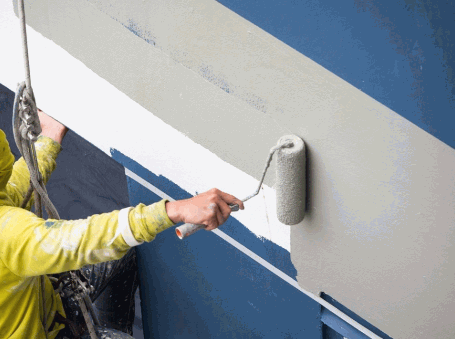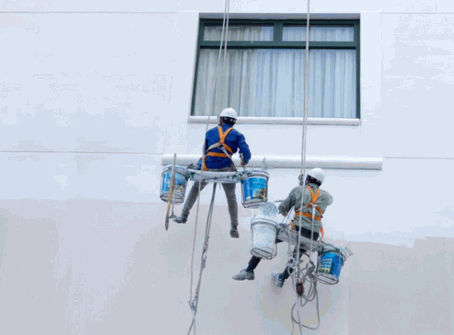Commercial painting, much like residential painting, is integral to enhancing the appearance and durability of business environments. This specialised field encompasses a range of painting services designed to address the distinct requirements of commercial properties, from revitalising interior spaces to safeguarding exterior surfaces. It includes both small-scale projects and large-scale projects, ensuring that all needs are met effectively. It is important to explore the various types of commercial painting, the benefits associated with it, the steps involved in executing a successful project, and the essential factors to consider when selecting a painting company. Effective project management and understanding different paint types play a crucial role in achieving successful outcomes. Whether the goal is to improve aesthetics or increase property value, a comprehensive understanding of commercial painting, including the specifics of paint finish and glossiness, is essential for making informed decisions.

What Is Commercial Painting?
Commercial painting encompasses a broad spectrum of painting services specifically tailored for commercial properties, including office buildings, retail spaces, and industrial facilities. This specialization highlights the critical importance of project management, adherence to quality standards, and compliance with safety regulations, all while ensuring high levels of customer satisfaction. Effective project scheduling and budget requirements are also key considerations.
Professional painters operating within this sector employ advanced painting equipment and techniques designed to address the varied needs of business owners, facilitating transformations that enhance aesthetic appeal and promote a positive environment. Their expertise levels ensure quality work whether dealing with residential projects or commercial properties.

What Are The Different Types Of Commercial Painting?
Commercial painting can be classified into several categories based on the specific requirements and characteristics of the project. These categories include interior painting, exterior painting, industrial painting, and specialty painting.
Each type employs distinct techniques and materials, which may encompass various paint types, finishes, and specialised coatings tailored to meet specific durability and aesthetic standards. Understanding different paint sheens is also critical for achieving desired outcomes. Recognising these distinctions is essential for business owners and property managers when selecting painting contractors for their residential or commercial projects, ensuring that the chosen professionals have the requisite painter expertise and experience levels for the task.
Interior Painting
Interior painting is a critical component of commercial painting, aimed at enhancing the indoor environment of commercial properties through meticulous colour selection and paint application. This process entails evaluating various surface types, including plasterboard, wood, and metal, to ensure optimal paint adhesion and finish. The use of appropriate paint supplies and tools like pressure washers, sandblasters, and paint sprayers can significantly enhance the result. The selection of appropriate paint types and techniques can significantly influence both the aesthetics and functionality of interior spaces, making it imperative for business owners to collaborate with skilled painting contractors who understand the importance of proper surface preparation and paint application.
When contemplating an interior painting, it is essential to consider colour psychology, as different hues can evoke specific emotional responses from occupants. Lighter colours typically foster a sense of space and tranquillity, while darker tones can introduce warmth and sophistication.
Moreover, proper surface preparation is paramount; this involves cleaning, repairing, and priming surfaces to guarantee a smooth application and enhance the longevity of the finish, which ultimately affects maintenance needs and maintenance costs.
- It is advisable to choose high-quality paints that are suitable for each environment, such as matte finishes for low-traffic areas and satin for durability in high-traffic zones.
- Utilising brushes and rollers designed for the specific type of paint can enhance the application process.
- Implementing a two-coat application generally results in more vibrant colours and more uniform coverage.
By understanding these considerations, property owners can significantly enhance the impact of their interior environments.

Exterior Painting
Exterior painting is essential for safeguarding commercial buildings against environmental factors while simultaneously enhancing their aesthetic appeal. This applies to both commercial painting and residential painting projects. This process necessitates comprehensive surface preparation to address issues such as weather damage, peeling paint, and dirt accumulation, thereby ensuring the durability of the paint application. A variety of paint types are available, each offering distinct levels of gloss, durability, and weather resistance; thus, it is imperative for property managers to comprehend their options for effective paint coverage.
Ahead of commencing the project, a meticulous inspection of the building’s exterior should be conducted to identify specific problem areas. This inspection typically includes using tools such as pressure washers and sandblasters:
- Power washing the surface to eliminate debris and old paint
- Repairing any structural issues, such as cracks or holes
- Applying a primer compatible with the selected paint type to enhance adhesion and longevity
When selecting products, it is important to consider factors such as local weather conditions and the substrate material. Products from reputable paint brands should be prioritized to ensure quality coverage. For instance, high-quality acrylic paint is generally ideal for regions with elevated moisture levels, while oil-based paints provide a durable finish in arid climates. The choice of paint finishes can also influence the overall durability and appearance.
In the finishing phase, utilising techniques such as rolling or spraying can ensure an even application, which is vital for protection against the elements and for maintaining the building’s aesthetic appeal. Proper scaffolding is often necessary to reach high areas safely.

Industrial Painting
Industrial painting refers to specialised painting services designed for manufacturing and industrial facilities, emphasising surfaces that necessitate high durability and compliance with stringent safety regulations. It requires an understanding of specific project timelines and budget requirements. This type of painting typically involves the application of specialised coatings that protect against corrosion, chemicals, and physical wear, making it essential for preserving the integrity of equipment and structures over time. The use of tools like paint sprayers and scaffolding is common in this field. Meeting specific maintenance requirements and quality standards is critical for the longevity of these industrial projects.
In the field of industrial painting, professionals face unique challenges arising from various factors, including surface types, environmental conditions, and safety protocols.
- For instance, the diversity of surfaces, such as metals, concrete, and plastics, requires a customised approach to ensure proper adhesion and durability.
- Safety considerations are paramount, as the application of certain coatings may release harmful fumes, thereby necessitating the use of personal protective equipment (PPE) and adequate ventilation. Ensuring that all safety protocols are followed is crucial for the well-being of workers.
- Ongoing maintenance is essential to ensure that the protective coatings remain effective, often involving regular inspections and touch-ups to maintain performance standards.
Effectively balancing these elements contributes to the success of an industrial painting project, ensuring it not only possesses visual appeal but also offers exceptional durability and protection against environmental factors. Regular inspections and touch-ups are part of ongoing maintenance needs.

Specialty Painting
Specialist painting encompasses a diverse array of unique finishes and techniques that enhance the aesthetic appeal of commercial spaces. This includes color combinations that can create striking visual effects. This includes the application of wall coverings, textures, and innovative colour combinations.
The execution of such specialist painting requires skilled commercial contractors who possess a deep understanding of the nuances associated with various surface types. These professionals often have extensive experience with different paint types and paint finishes. These professionals are adept at implementing intricate designs while adhering to stringent quality standards and fulfilling customer expectations. The appropriate application of specialist painting can transform ordinary spaces into visually captivating environments that create a lasting impression.
Exploring faux finishes and decorative wall coverings can further amplify these transformations. Faux finishes effectively replicate the appearance of materials such as marble, wood, or metal, thereby adding depth and richness to the overall design. The incorporation of textured paint can introduce visual interest and subtle elegance, aligning well with themed décor or modern aesthetics.
- Faux Finishes: Mimics various materials.
- Textured Paint: Adds depth and dimension.
- Wall Coverings: Versatile options for style.
Engaging professional painters who specialise in these techniques is essential to ensure that each project meets high aesthetic standards. This commitment ultimately contributes to the creation of a vibrant and inviting commercial atmosphere that enhances overall business operations.

What Are The Benefits Of Commercial Painting?
Commercial painting provides a range of benefits that go beyond aesthetics, significantly contributing to customer satisfaction, property value, and surface protection. Effective project management ensures that all aspects of the project are handled efficiently, from start to finish. By investing in professional painting services, business owners can enhance the visual appeal of their commercial properties, attracting more customers and fostering a positive environment. Experienced painters deliver high-quality results that stand the test of time.
Furthermore, the application of high-quality paint serves to safeguard surfaces against environmental damage, thereby prolonging the property’s lifespan and minimising long-term maintenance costs. Choosing the right paint brands and paint supplies is crucial for achieving these benefits.
Improves Aesthetics
Residential and commercial painting both offer opportunities to improve aesthetics significantly, impacting the overall impression of the property.
One of the primary advantages of commercial painting lies in its capacity to significantly enhance aesthetics, transforming uninspired spaces into vibrant and inviting environments. Through meticulous colour selection and professional application, businesses can elevate their visual appeal, fostering a welcoming atmosphere that resonates with both customers and employees. A well-executed paint job can serve as a vital element in branding and marketing initiatives.
When evaluating the impact of aesthetics on customer perceptions, it is essential to acknowledge how colours evoke emotions and set the tone of a space. For example, businesses should consider not only commercial but also residential painting approaches when applying these principles:
- Warm colours, such as reds and yellows, can stimulate feelings of excitement and energy, making them particularly effective in restaurants and retail environments.
- Cool colours, including blues and greens, often promote calmness and relaxation, making them suitable for healthcare facilities and office settings.
Employing colour schemes that reflect a brand’s identity can enhance brand recognition and foster customer loyalty. These schemes can be effectively applied not only in commercial settings but also in homes to create cohesive and inviting environments.
Intentional visual appeal, achieved through professional painting, not only improves the overall environment but can also influence consumer behaviour, ultimately driving sales and enriching the customer experience.
Increases Property Value
Investing in commercial painting can significantly enhance property value, as both well-maintained exteriors and interiors contribute to improved market appeal. Regularly scheduled painting services not only elevate aesthetic quality but also reflect proactive property management, which prospective buyers and renters tend to appreciate.
By addressing maintenance needs through a professional painting job, business owners can optimise their return on investment when the time comes to sell or lease their properties.
Statistics indicate that properties with freshly painted exteriors can experience a value increase of up to 10%, making this investment particularly advantageous for business owners seeking to enhance marketability. When contemplating the sale or lease of a property, potential buyers are often attracted to well-maintained structures. Notably:
- 68% of potential renters indicated a greater willingness to pay higher rents for visually appealing properties.
- 53% of homebuyers reported that the quality of exterior paint significantly influenced their purchasing decisions.
A high-quality paint job serves as a protective barrier against weathering and deterioration, thereby extending the lifespan of structural elements and reducing long-term maintenance costs.
Consequently, scheduling routine painting not only provides immediate aesthetic benefits but also supports sustainable investment practices, ensuring that property values remain competitive in a fluctuating market.
Protects Surfaces
Commercial painting serves to protect surfaces from environmental damage, thereby extending the lifespan of building materials and reducing maintenance requirements. Utilising high-quality paint finishes specifically formulated for exterior or interior applications provides essential protection against moisture, ultraviolet (UV) rays, and other factors that contribute to wear and tear. This preventative approach not only safeguards the investment in the property but also ensures that its appearance remains fresh and appealing over time.
Along with protecting against moisture and UV damage, commercial paint significantly enhances the overall durability of a building’s surfaces. Many contemporary paint products incorporate advanced protective agents that resist fading, cracking, and peeling—issues that are prevalent in harsh climates. Property owners can greatly benefit from understanding the following factors:
- Moisture Resistance: High-quality finishes create a barrier that prevents water infiltration, thereby avoiding mould and structural damage.
- UV Protection: Certain paints are formulated with UV blockers that maintain vibrant colours and protect surfaces from the sun’s deteriorating effects.
- Minimal Maintenance: A robust paint coating reduces the frequency of upkeep, resulting in cost savings over time.
Implementing a comprehensive commercial painting strategy is essential for preserving the beauty and integrity of a property for years to come.
Enhances Safety
Enhancing safety is a significant advantage of commercial painting, notably through the application of high-visibility colours and finishes that adhere to safety regulations. Properly marked areas, such as walkways and hazard zones, are instrumental in preventing accidents and ensuring that both employees and customers remain aware of their surroundings. Regular maintenance and repainting further contribute to a safer environment by addressing wear and tear that could potentially lead to hazardous situations. Moreover, human resources departments should consider the impact of a visually safe environment on employee well-being and productivity.
In evaluating the impact of commercial painting on workplace safety, it is essential to acknowledge that colours convey specific meanings and evoke particular emotions. For example, bright yellows or oranges typically signify caution, while greens are commonly associated with safety or approval signals. This deliberate use of colours aids in the creation of a visually navigable space.
- Compliance with health and safety guidelines is also critical in the selection of appropriate hues and finishes for varied workspaces.
- Conducting regular inspections and maintenance ensures that colours remain vibrant and effective, thereby fostering a culture of safety and awareness among employees.
Faded or peeling paint can significantly diminish the effectiveness of safety markings, thereby increasing the likelihood of accidents. Thus, it is imperative to mitigate neglect through timely touch-ups and comprehensive repainting schedules to promote overall safety and well-being within commercial spaces.

What Are The Steps Involved In Commercial Painting?
The steps involved in commercial painting are essential for achieving a successful project outcome. These steps encompass careful planning, thorough surface preparation, the painting process itself, and the application of finishing touches.
Effective project management and scheduling are vital in minimising disruptions to business operations while ensuring that each phase is completed in accordance with established quality standards. Each step is significant in delivering a high-quality finish that aligns with the client’s vision and expectations.
Surface Preparation
Surface preparation serves as the foundation of successful commercial painting, encompassing the assessment and treatment of surfaces to ensure optimal paint adhesion and durability.
To attain the highest standards, it is imperative for professionals in the field to employ a variety of techniques tailored to different surface conditions.
- Cleaning: This initial step involves the removal of contaminants such as dust and grease that may hinder adhesion.
- Sanding: The application of abrasive materials facilitates the creation of a smooth surface, which aids in the even application of paint.
- Priming: The application of a primer coat effectively seals the surface, enhancing adhesion and preventing potential future issues.
By meticulously attending to these tasks, skilled contractors not only enhance the aesthetic appeal of the work but also prolong the longevity of paint applications. This approach aligns with maintenance objectives and optimises project management efficiency.
Priming
Priming is a critical step in the commercial painting process that prepares surfaces for paint application, thereby enhancing both paint coverage and durability. Different types of paint necessitate specific primers, and a thorough understanding of the surface types involved can lead to more effective results.
A knowledgeable approach to priming ensures that the application process is not only efficient but also contributes to long-lasting outcomes. Various types of primers are available, including oil-based, emulsion, and shellac primers, each designed for specific surfaces such as plasterboard, wood, or metal.
For instance, oil-based primers are particularly effective for sealing knots in wood or blocking stains, while emulsion primers are commonly used for plasterboard and offer the convenience of easy cleanup with water.
Additionally, specialised primers are available for particular scenarios, such as adhesion promoters for challenging gloss finishes or mould-resistant options for high-moisture environments. When selecting a primer, it is crucial to consider the existing condition of the surface, the type of paint being used, and the relevant environmental factors.
This consideration not only ensures optimal adhesion and colour retention but also significantly enhances the longevity of the paint application.

Painting
The painting stage involves the meticulous application of paint utilising various tools and techniques that are specifically tailored to meet project requirements and achieve the desired finishes. Professional painters employ specialised equipment, such as paint sprayers and rollers, to ensure even coverage while adhering to project schedules, thereby minimising disruption to the surrounding environment. While professional services are recommended, some property owners may opt for DIY painting to reduce labour costs. However, it is essential to consider the potential challenges and limitations of such approaches.
When considering paint application, selecting the appropriate tools can significantly enhance the final result. For instance, paint sprayers are often favoured for large surface areas due to their efficiency, while rollers offer greater precision for smaller sections. Brush techniques are also essential for addressing intricate details and corners, ensuring that no area is left unpainted.
Proper scheduling is equally critical; addressing the appropriate spaces at optimal times prevents unnecessary overlap and can expedite drying times. By assessing environmental factors such as humidity and temperature, professionals can make informed decisions regarding the selection of paint, including emulsion paints, oil-based paints, and eco-friendly options.
This approach aligns with both durability requirements and aesthetic objectives, ultimately contributing to the successful outcome of the project.

Finishing Touches
Finishing touches in commercial painting are essential for achieving a polished and professional appearance that adheres to quality standards while enhancing customer satisfaction. This final stage involves a comprehensive inspection of the work, rectifying any imperfections, and ensuring that all details align with the client’s expectations. By emphasising these finishing touches, painting contractors can deliver a project that not only meets aesthetic criteria but also functions effectively within the commercial environment.
To appreciate their significance, it is important to recognise that these minute details often distinguish a satisfactory job from an exceptional result. The inspection process typically entails a thorough review of the painted surfaces, assessing consistency in colour, texture, and finish. Touch-ups are crucial as they address minor flaws that could detract from the overall aesthetic appeal.
- A commitment to quality can be demonstrated by promptly addressing client feedback.
- Improved client relations are fostered through these meticulous efforts.
- Attention to detail is indicative of building trust and credibility within the industry.
Therefore, the diligence applied during this final step not only safeguards the integrity of the project but ultimately enhances customer satisfaction, thereby reinforcing the contractor’s reputation in a competitive market.
What Factors Should Be Considered When Choosing A Commercial Painting Company?
When selecting a commercial painting company, it is essential to consider several factors to ensure a successful project outcome. These factors include the company’s experience, the quality of materials used, customer reviews, cost estimates, and color selection.
A reputable painting contractor will have a proven track record of delivering projects that meet established quality standards while adhering to budget constraints and timelines. Business owners should prioritize companies that demonstrate expertise in commercial painting and possess a comprehensive understanding of the unique requirements associated with commercial properties.
Experience And Expertise
Experience and expertise are paramount considerations when selecting a commercial painting company, as these factors directly impact the quality of work and overall customer satisfaction. Companies with extensive industry experience typically possess the requisite skills, knowledge, and tools necessary to execute a variety of painting projects efficiently. Business owners are advised to inquire about previous projects and the specific experience levels of painting contractors to ensure the selection of a reputable team.
This selection process becomes even more critical when evaluating the scope and timeline of projects, which can vary considerably. Experienced contractors often provide valuable insights that can lead to time savings and cost reductions, ensuring that projects remain within budget.
Moreover, they are proficient in addressing common challenges such as weather-related delays, special coatings, and the need for thorough surface preparation, both of which can significantly affect the final outcome. The following are key advantages that seasoned professionals offer:
- Expert surface assessment to identify underlying issues prior to the commencement of painting.
- Knowledge of the most suitable materials and techniques for specific environments.
- Efficient project management skills that ensure adherence to deadlines.
- Access to a network of suppliers providing top-quality products.
Therefore, by prioritising experience, business owners can greatly enhance their likelihood of achieving an impeccable finish that not only meets but exceeds expectations.
Quality Of Materials Used
The quality of materials used in commercial painting plays a crucial role in determining the durability and longevity of the paint application, making this an essential factor during the selection process. High-quality paint types and supplies enhance coverage, provide vibrant finishes, and offer resistance to environmental factors, thereby reducing maintenance requirements.
It is imperative to select reputable brands and products. This consideration not only affects aesthetic outcomes but also influences the long-term performance of the paint.
For business owners, the use of trusted materials results in:
- Increased durability: Premium paints generally resist wear and tear more effectively than lower-quality alternatives.
- Lower maintenance costs: A reduction in the need for touch-ups and repaints leads to significant savings over time.
- Enhanced satisfaction: A high-quality finish can elevate the overall atmosphere of a space, reflecting professionalism and attention to detail.
Additionally, considering residential painting techniques can sometimes apply to commercial projects for a personalised touch. Furthermore, it is recommended to collaborate with painting professionals who are dedicated to using superior materials, remain informed about industry advancements, and understand the various environmental challenges that different spaces may encounter.
Customer Reviews And References
Customer reviews and references are essential tools for evaluating the reputation and reliability of a commercial painting company, offering insights into their quality standards and project timelines. Understanding customer feedback not only aids in identifying the strengths of potential contractors but also highlights areas that may warrant caution. By reviewing testimonials and requesting references from previous clients, business owners can gain a clearer understanding of the company’s performance, professionalism, and ability to adhere to deadlines.
This feedback can significantly inform the decision-making process and facilitate a successful collaboration. To effectively evaluate reviews, consider the following methods:
- Look for patterns in the feedback, focusing on common themes related to quality and service.
- Assess the recency of the reviews; more recent feedback typically reflects the company’s current operational practices.
- Evaluate the company’s response to negative reviews, as this demonstrates their commitment to customer satisfaction.
Additionally, contacting provided references can yield crucial qualitative insights. By systematically analyzing this information, business owners can make informed decisions and establish a productive partnership with the selected painting contractor.
Cost And Time Estimates
Accurate cost and time estimates are essential for effective project management and budgeting when selecting a commercial painting company. Business owners should obtain detailed quotes that specify all anticipated expenses, including materials and labour, to ensure they are making informed decisions. Time estimates are critical for planning the project’s schedule, as unexpected delays can disrupt business operations and adversely affect overall customer satisfaction.
To initiate this process, it is important to reach out to multiple painting companies and request detailed proposals that encompass not only pricing but also a comprehensive breakdown of the services provided.
When requesting quotes, consider the following:
- Request transparency regarding labour rates and material costs.
- Inquire about specific timelines and any potential factors that may impact project completion.
- Seek references or testimonials to assess their previous performance.
Maintaining open lines of communication throughout the process is vital. Effective dialogue fosters trust and allows business owners to clarify expectations while verifying the credibility of the painter’s proposals. By ensuring a clear understanding of both budget and schedule, a smoother project execution can be achieved, ultimately leading to enhanced satisfaction.
Find out more: How Much Does It Cost To Spray Paint uPVC Windows

How To Prepare For A Commercial Painting Project?
Preparing for a commercial decorating project requires a systematic approach that encompasses several essential steps to facilitate a seamless process. These steps include:
- Defining the scope of work
- Establishing a budget
- Selecting appropriate colours and finishes
- Maintaining effective communication with the decorating contractor
- Considering the possibility of DIY painting for smaller areas
Establishing a clear project schedule and budget is crucial to minimising disruptions to daily operations and ensuring alignment with overall business objectives. While DIY painting can be considered for smaller tasks, a well-organised approach can significantly enhance both the efficiency and success of larger decorating projects.
Determine The Scope Of Work
Determining the scope of work is a critical initial step in preparing for a commercial painting project, as it delineates the specific tasks, timelines, and resources necessary to achieve the desired outcomes. This assessment enables business owners to articulate their expectations clearly to painting contractors, ensuring that all parties comprehend the objectives and requirements for effective project management.
A well-defined scope is instrumental in preventing misunderstandings and mitigating the risk of scope creep throughout the duration of the project.
Accurately defining the scope of work commences with a comprehensive assessment of the areas designated for painting. This process involves not only measuring the square footage but also evaluating the conditions of the surfaces, as some may necessitate special preparation or repair work prior to the application of paint. It is equally important to consider any unique factors that could complicate the project, such as high ceilings or challenging access points.
Key areas that may require special attention include:
- Ceilings and walls with intricate designs
- Exterior surfaces exposed to inclement weather
- Spaces where specific safety regulations must be observed
By proactively addressing these challenges, businesses can ensure that the commercial painting project progresses smoothly and adheres to the established timeline and budget.
Set A Budget
Establishing a budget for a commercial painting project is crucial for maintaining financial oversight and ensuring the project aligns with overarching business objectives. Business owners should account for all potential expenses, including materials, labour, and any unforeseen costs, to formulate a realistic budget that adheres to financial constraints. By communicating this budget to painting contractors at the outset, businesses can facilitate clear discussions and prevent misunderstandings throughout the duration of the project.
Effective budgeting not only promotes accountability but also enhances decision-making during the painting process. The importance of precise cost estimation cannot be overstated, as it aids in identifying areas where cost savings may be achieved without compromising quality.
To develop a comprehensive budget, consider the following steps:
- Identify all necessary materials: Compile a list of each type of paint and quantity required, along with any essential tools.
- Estimate labour costs: Research prevailing wage rates in your locality to accurately project labour expenses.
- Factor in contingencies: Allocate a percentage of the budget for unforeseen expenses, thereby ensuring financial flexibility.
By implementing these critical steps, business owners can establish a well-structured budget that effectively guides their commercial painting project, ultimately leading to successful outcomes.
Choose Colours And Finishes
Selecting the appropriate colours and finishes for a commercial painting project is essential for achieving the desired aesthetic and fostering a cohesive environment. Business owners should take into account various factors such as existing décor, branding, and the psychological effects of colours when determining suitable colour combinations and paint finishes. Engaging with professional painters can offer valuable insights into current trends and best practices in colour selection.
It is crucial to recognise the impact of colour psychology on customer perception and brand identity when making these significant decisions. For instance, vibrant colours can evoke feelings of energy and creativity, while muted tones typically convey sophistication and calmness.
- Current Design Trends: Minimalism continues to be a favoured approach, emphasising neutral palettes complemented by bold accent colours.
- Branding Considerations: The chosen colours should align with the brand’s message and resonate with the target audience.
Ultimately, a thorough understanding of how colours and finishes can enhance the overall ambience will ensure that the space resonates positively with both clients and employees, thereby creating a welcoming and impactful environment.
Communicate With The Painting Company
Effective communication with the painting company is essential for ensuring the success of the project and meeting expectations throughout the commercial painting endeavour. Engaging in clear dialogue regarding timelines, costs, and specific preferences facilitates alignment between the contractor’s work and the client’s vision, thereby enhancing overall customer satisfaction. Regular check-ins and updates can promote a smoother workflow and allow for timely adjustments as necessary.
Cultivating a strong relationship between both parties not only improves morale but also ensures that any concerns are addressed promptly, significantly reducing the potential for delays. By prioritising open lines of communication, clients can articulate their desires while receiving immediate feedback on feasibility from the contractor, resulting in a more efficient process.
Key practices to consider include:
- Encouraging transparency in cost estimates
- Discussing potential hurdles or necessary changes
- Setting realistic timelines based on ongoing discussions
These practices establish a solid foundation of trust, which is integral to effective project management and ultimately fosters a healthier and more productive partnership.
